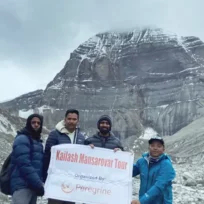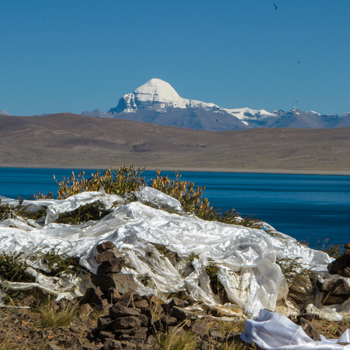Nestled amidst the awe-inspiring landscape surrounding Mount Kailash, Zutul Puk stands as a revered monastery and a crucial respite for pilgrims on the sacred kora. This spiritual sanctuary holds deep meaning for those undertaking the demanding pilgrimage circuit.
For centuries, weary travelers have found solace and refuge within Zutulphuk’s walls, protected from the rugged terrain. It’s where spiritual seekers recharge, reflect upon their trip, and connect with the region’s rich history and traditions.
Zutul Puk Monastery’s Strategic Significance
Zutul Puk, meaning “Cave of Miracles,” is strategically positioned along the eastern flank of Mount Kailash, approximately 14 kilometers from Darchen, the kora’s starting point. It marks the culmination of the second day’s trek, a particularly challenging section known for its rugged terrain. The Zutul Puk monastery’s location provides pilgrims with a much-needed haven to rest and recuperate before continuing their arduous tour.
Beyond its practical importance, Zutulphuk is a site of immense spiritual significance, steeped in history and filled with sacred relics. The monastery itself is a testament to the unwavering faith of the Tibetan people and their deep reverence for Mount Kailash.

Zutul Puk’s Landscape and Climate: A Harsh Yet Heavenly Journey
Zutul Puk, nestled amidst the majestic Mount Kailash landscape, offers a unique blend of natural splendor and spiritual significance. Its surroundings feature rugged terrain, soaring altitudes, and ever-changing weather patterns, creating a demanding yet advantageous experience for pilgrims and trekkers.
Rugged Beauty Surrounding Zutul Puk
The glacier-fed Lha Chu river carves a valley beneath Zutulphuk as it flows towards the sacred Mount Kailash. Towering peaks, often crowned with snow and ice, frame the horizon, offering breathtaking panoramas. Rocky slopes, scree fields, and alpine meadows dotted with vibrant wildflowers create a rugged yet enchanting landscape. The thin, crisp air serves as a constant reminder of the high altitude.
Weather at Zutul Puk: Expect the Unexpected
Zutul Puk’s weather is as unpredictable as it is captivating, so visitors must prepare for various conditions.
- Summer (June-August): During the day, enjoy comfortable temperatures averaging between 10°C and 15°C. However, be prepared for nighttime temperatures that can dip below freezing, requiring warm layers to stay relaxed. Summer also brings the monsoon season, so expect occasional rain showers and snow at higher elevations.
- Autumn (September-November): Many consider this the prime time to visit Zutul Puk Monastery. Clear skies offer stunning views of Mount Kailash, and daytime temperatures are comfortable, but remember to pack for chilly nights.
- Winter (December-February): Zutul Puk’s winters are harsh, with heavy snowfall and frigid temperatures. The trekking route is often inaccessible during this time.
- Spring (March-May): Warmer temperatures return in spring, but expect unpredictable weather. Snowmelt can muddy and slippery trails, adding an extra challenge to your trek.
Gearing Up for Zutul Puk’s Climate
To ensure a safe and fulfilling pilgrimage, pack strategically:
- Dress in Layers: Adapt to the changing temperatures by layering your clothing.
- Pack Waterproof Gear: A waterproof jacket and pants are crucial, even in the summer.
- Stay Warm: Remember a down jacket, thermal layers, gloves, and a hat, regardless of the season.
- Protect Your Skin and Eyes: The high-altitude sun is intense, so pack sunscreen and sunglasses.
- Choose Sturdy Footwear: Invest in sturdy, waterproof boots to tackle the rocky terrain.
Altitude Awareness
Zutul Puk is 4,790 meters (15,715 feet) above sea level. Altitude sickness can be a concern, so take it slow for the first few days to allow your body to acclimatize. Stay hydrated, avoid alcohol, and pay attention to how your body feels.
Combining natural beauty, spiritual significance, and challenging conditions, Zutulphuk is a truly unique destination. With careful preparation, visitors can experience a transformative tour of this sacred site.
Sacred Haven on the Zutul Puk Pilgrimage
Zutul Puk, nestled in the majestic shadow of Mount Kailash and known as the “Cave of Miracles,” holds deep spiritual meaning for those undertaking the sacred kora. This Tibetan Buddhist monastery offers weary pilgrims a much-needed resting place and serves as a powerful vortex for spiritual reflection and connection.
Zutul Puk’s Sacred Significance in Tibetan Buddhism
Tibetan Buddhists revere Zutulphuk as a beyul, a hidden land brimming with sacred energy. They believe it to be a dwelling place for enlightened beings where practitioners can accelerate their spiritual growth. The monastery belongs to the Gelugpa tradition, a branch of Tibetan Buddhism emphasizing monastic discipline and rigorous study. Pilgrims often visit Zutul Puk to receive blessings from the resident monks, engage in communal prayers, and meditate in the tranquil surrounding caves.
Beyond Buddhism: A Place of Reverence for All
Zutul Puk Mount Kailash’s spiritual significance extends beyond Tibetan Buddhism. Mount Kailash and the surrounding area hold deep meaning for various faiths, including Hinduism, Jainism, and the Bon tradition. Each tradition carries unique beliefs and practices associated with this sacred mountain and its environs.
Legends and Lore of Zutul Puk
Legends and stories centered on the revered Tibetan yogi Milarepa permeate the history of Zutulphuk. Milarepa is said to have meditated in a cave near the monastery, and his spiritual presence lingers, inspiring visitors to this day. Other tales mention hidden treasures and miraculous events connected to this sacred site.
Spiritual Practices at Zutul Puk
Pilgrims visiting Zutul Puk engage in various spiritual practices:
- Kora: The circumambulation of Mount Kailash is a central practice for pilgrims of all faiths. Travelers often undertake this physical and spiritual tour with deep devotion and reverence.
- Prayer: The monastery’s main assembly hall and smaller shrines scattered throughout the complex invite pilgrims to offer prayers and find moments of quiet reflection.
- Meditation: This serene environment provides an ideal backdrop for contemplation and introspection.
- Prostrations: Some pilgrims engage in prostrations, a physical act of devotion involving lying flat on the ground and extending their arms.

A Pilgrim’s Sanctuary on the Mount Kailash Kora
Nestled along the sacred Mount Kailash Kora, Zutul Puk offers a profound spiritual experience. This Tibetan Buddhist monastery provides more than rest for weary travelers; it’s a haven for the soul, a place to reconnect with oneself.
A Spiritual Oasis at Zutul Puk
As you arrive at Zutul Puk, tranquility and reverence wash over you. The monastery’s unassuming architecture blends seamlessly with the rugged landscape, fostering peace and contemplation. Embracing the Sacred at Zutulphuk:
- Spin the Prayer Wheels: Each rotation of the prayer wheels that line the pathways sends out prayers and blessings.
- Walk the Monastery Kora: Many pilgrims deepen their spiritual connection by performing a smaller kora around the monastery.
- Leave Offerings: Butter lamps, incense, and vibrant prayer flags symbolize devotion and gratitude as you leave them as offerings.
- Find Peace in Meditation: The tranquil atmosphere fosters deep meditation, allowing you to explore your spiritual practice profoundly.
- Seek Blessings: The resident monks offer blessings, guidance, and support on your spiritual path.
- Witness Ancient Rituals: Observe the daily rituals and practices of the monks to gain insight into the traditions of Tibetan Buddhism.
- Explore Sacred Caves: Nearby meditation caves associated with Milarepa offer additional opportunities for contemplation and spiritual growth.
Tips for a Meaningful Pilgrimage
- Plan Ahead: Secure the necessary permits for Mount Kailash Kora and travel in Tibet well in advance.
- Respect Local Customs: Show your respect by dressing modestly and observing the monastery’s customs and traditions.
- Offer Gifts of Devotion: Consider bringing small offerings like butter lamps, incense, or prayer flags.
- Prepare for the Altitude: This place sits at a high altitude. Allow time to acclimatize and stay hydrated.
- Open Your Heart: Embrace the spiritual atmosphere and allow the transformative experience to unfold.
Zutul Puk Lodging: Embracing Simplicity in the Shadow of the Sacred Mountain
Accommodations near Mount Kailash in Zutul Puk mirror the region’s remoteness and the pilgrimage’s spiritual essence. They are basic yet cozy. While amenities may be limited, the warmth of the local people and the stunning scenery more than make up for it.
Choosing Your Shelter
- Guesthouses: These humble abodes, clustered around the monastery, offer dormitory-style rooms with shared bathrooms. Expect simple beds and blankets but plenty of camaraderie with fellow pilgrims.
- Teahouses: Warm up and refuel at these charming establishments with a hot meal or drink. Some offer basic lodging, too, often with shared rooms or floor space for sleeping bags.
What to Expect
- Electricity: Some guesthouses offer electricity for a few hours each evening, but it can be unreliable. Bring a portable charger for your devices.
- Running Water: Hot water is often limited or unavailable. Many places use solar-heated water, so expect chilly showers, especially in the mornings and evenings.
- Food and Drink: Teahouses and guesthouses serve simple, hearty Tibetan meals like thukpa (noodle soup), momos (dumplings), and rice. Snacks and drinks are available, but options are limited.
- Wi-Fi: Embrace the digital detox! Reliable Wi-Fi is scarce here.
Packing Essentials
- Sleeping Bag: Bring your warm sleeping bag for a good night’s sleep.
- Headlamp or Flashlight: These are essential for navigating after dark and during power outages.
- Toiletries: Remember toilet paper, hand sanitizer, wet wipes, and other personal hygiene items.
- First-Aid Kit: Pack basic medical supplies for altitude sickness, minor injuries, and joint ailments.
- Snacks and Water Bottle: Carry extra snacks and water, especially if you plan to explore the surrounding areas.
- Warm Clothing: Temperatures can drop significantly, even in summer, so pack layers of warm clothes.
- Waterproof Gear: Be ready for rain or snow any time of year with a waterproof jacket and pants.
The Beauty of Simplicity
The spartan Accommodations in Zutul Puk reflect the pilgrimage’s core values of simplicity, humility, and a focus on the spiritual tour. By embracing the minimalist comforts, you can entirely focus on your inner tour and connect with the sacred landscape.
Your Guide to a Sacred Journey
Located on the eastern slopes of Mount Kailash, Zutul Puk is a crucial stop on the revered kora pilgrimage. This guide equips you with essential information for reaching this sacred site and completing your trip around the holy mountain.
Descending from Dirapuk to Zutul Puk
The trek from Dirapuk to Zutulphuk spans approximately 18 kilometers (11 miles), usually taking 6-8 hours. The path descends from the high Dolma La pass, winding through a picturesque valley. Critical Considerations for the Descent:
- Rise Early: Start your trek in the early morning to beat the harsh afternoon sun.
- Stay Hydrated and Fueled: The descent can dehydrate you, so carry plenty of water and energizing snacks.
- Soak in the Scenery: As you descend, the landscape dramatically transforms, unveiling stunning vistas of Mount Kailash and the surrounding valleys.
- Listen to Your Body: Take breaks when necessary and pace yourself.
Continuing from Zutul Puk to Complete the Kora
After a night of rest at Zutul Puk, resume your tour to complete the kora. The trail leads you through a relatively flat valley, past meadows and streams. Additional Tips:
- Hydration is Key: The intense sun can rapidly dehydrate you, so ensure you drink water regularly throughout the day.
- Share the Trail with Yaks: You’ll encounter these gentle giants on the trail. Give them space and avoid startling them.
- Enjoy the Final Steps: The last leg of the kora is a leisurely walk back to Darchen, where your pilgrimage began.
Preparing for Your Trek
- Acclimatize to the Altitude: Before the kora, spend a few days in Darchen to allow your body to adjust to the high altitude.
- Consider a Porter: If your backpack feels heavy, hiring a porter to carry your gear can lighten your load.
- Seek Guidance: Consider hiring a knowledgeable Zutul Puk trekking guide for a deeper understanding and a safer Zutul Puk trek. Their expertise in the region’s history and culture goes beyond navigation. They’ll share captivating stories, enriching your journey while ensuring you confidently traverse the trails.
Overcoming Challenges at High Altitude
Trekking to Zutul Puk, a crucial stop on the sacred Mount Kailash Kora, tests your physical endurance and spiritual fortitude. Thorough preparation and a clear understanding of these challenges pave the way for a safe and spiritually fulfilling pilgrimage.
Tackling Physical Obstacles
The Zutulphuk section of the Kora presents demanding terrain. Pilgrims face steep ascents and descents, rocky paths, and high altitudes, which make breathing more difficult. Unpredictable weather can bring sudden temperature changes and snowfall, even in warmer months.
Addressing Health Concerns at Altitude
Acute mountain sickness (AMS) poses this altitude’s most significant health risk. Symptoms include headache, nausea, fatigue, dizziness, and sleep disturbances. If left untreated, AMS can become dangerous. Dehydration, sunburn, and hypothermia are other potential health issues to be aware of.
Preparation: Your Key to Success
Preparation is your best defense against the challenges of the Zutul Puk trek. Follow these essential tips:
- Acclimatize Gradually: Spend a few days in Darchen (the kora’s starting point) to allow your body to adjust to the altitude. Avoid strenuous activity and stay hydrated during this time.
- Prioritize Fitness: The Kora demands physical fitness, so prioritize getting in shape before your trip. Regular exercise and cardiovascular training can help you tackle the challenging terrain.
- Pack Smart: Bring warm layers, waterproof gear, sturdy hiking boots, and a first-aid kit with medication for AMS.
- Hydrate Regularly: Carry a water bottle and take frequent sips throughout the day to avoid dehydration headaches and stay energized for your Darchen trek. Proper hydration is critical to a safe and enjoyable pilgrimage.
- Shield Yourself from the Sun: The high-altitude sun is intense, so wear sunscreen, sunglasses, and a hat.
- Listen to Your Body: If you experience any symptoms of AMS, rest and descend to a lower altitude if necessary.
- Consider a Porter or Guide: Hiring a porter can help you carry your gear, while a Zutul Puk trekking guide can assist with navigation and offer local knowledge.
- Talk to Your Doctor: Consult your doctor before the trek, particularly if you have health issues.
Rewards Outweigh Challenges
The trek to Zutul Puk may be challenging, but the rewards are profound. The breathtaking scenery, the spiritual energy of the area, and the sense of accomplishment make this a pilgrimage worth every step.
By preparing thoroughly and respecting the challenges, you can confidently undertake this sacred tour and open yourself to the transformative power of Zutulphuk and Mount Kailash.
Capturing the Majesty of Mount Kailash in Photographs
Nestled within the dramatic landscape of Mount Kailash, Zutul Puk offers photographers a treasure trove of breathtaking scenery. Whether you’re a seasoned pro or an amateur, these tips and recommendations will help you capture the essence of this sacred site during your Zutul Puk pilgrimage. Mastering the Light:
- Golden Hour Glow: Capture the soft, warm light of sunrise and sunset as it bathes Mount Kailash and the surrounding valleys in a magical glow.
- Embrace the Dramatic Clouds: Cloudy skies add drama and depth to your photos, creating a unique and evocative atmosphere.
- Play with the Shadows: The rugged terrain around Zutul Puk casts captivating shadows throughout the day. Experiment with angles and perspectives to capture these intricate patterns.
Prime Photo Spots
- The Monastery: The monastery’s traditional design and colorful prayer flags dancing in the breeze make for an enchanting picture.
- The Valley of Lha Chu: Frame the meandering Lha Chu river as it flows towards Mount Kailash, nestled between majestic peaks.
- Dolma La Pass: Ascend to the highest point on the Kora for panoramic views of the entire region, encompassing Mount Kailash, Lake Gauri Kund, and the vast Tibetan plateau.
- Prayer Flag Displays: Throughout the trek, you’ll encounter vibrant arrays of prayer flags. These colorful displays add a spiritual touch to your photos.
- Quiet Caves: The caves surrounding Zutulphuk, rumored to have been used by Milarepa, create a unique, contemplative atmosphere for photography.
Practical Tips
- Protect Your Gear: The weather can change swiftly, so shield your camera equipment from rain, snow, and dust.
- Pack Extra Batteries: Cold temperatures drain batteries quickly, so bring spares to ensure you don’t miss a shot.
- Respect the Surroundings: Avoid disturbing the natural landscape or wildlife while photographing.
- Practice Patience: The best photos often require waiting for the perfect light or moment.
- Get Creative: Experiment with different angles, compositions, and settings to capture unique and creative images.
Zutul Puk: A Photographer’s Dream
Zutul Puk’s stunning scenery, spiritual energy, and unique cultural elements provide endless possibilities for photographers. By following these tips and seeking out the best viewpoints, you can capture the essence of this sacred place and preserve the memories of your pilgrimage.







